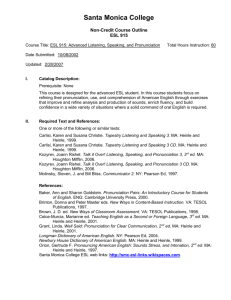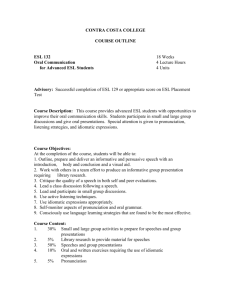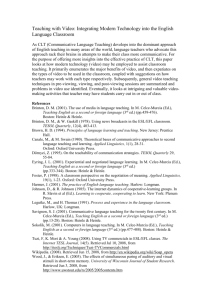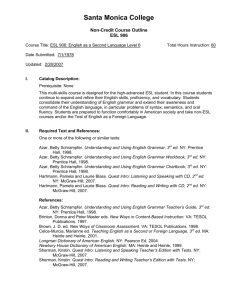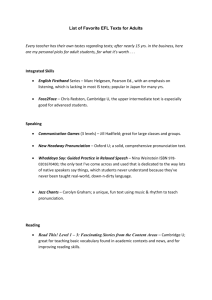ESL 913 Course Outline 2.07
advertisement
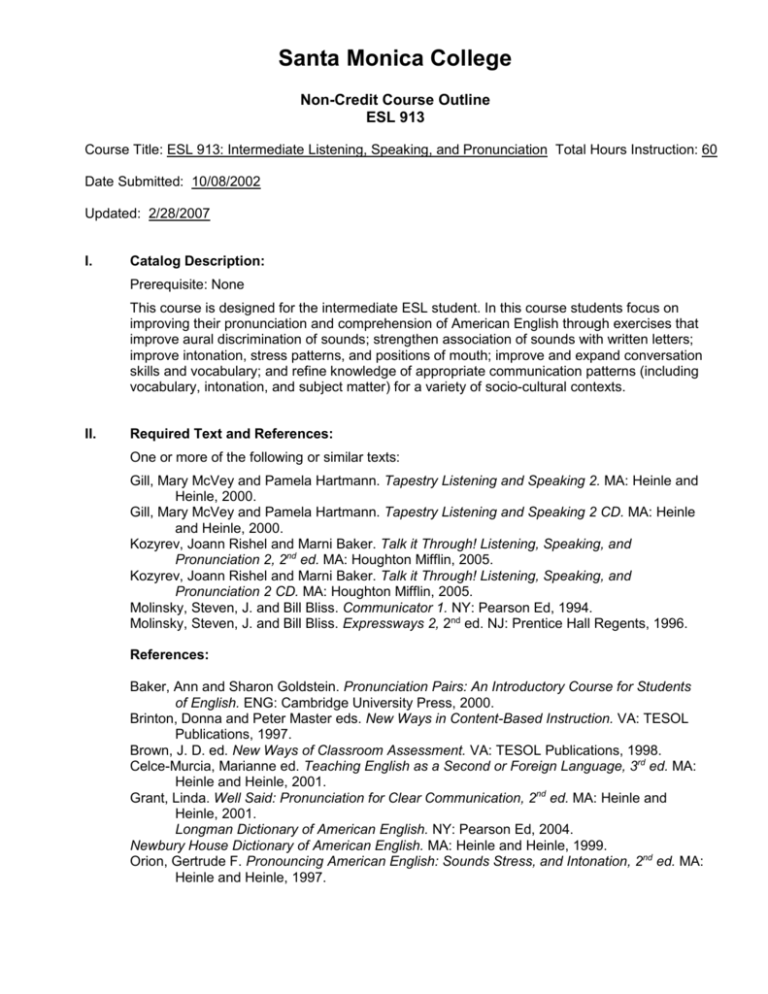
Santa Monica College Non-Credit Course Outline ESL 913 Course Title: ESL 913: Intermediate Listening, Speaking, and Pronunciation Total Hours Instruction: 60 Date Submitted: 10/08/2002 Updated: 2/28/2007 I. Catalog Description: Prerequisite: None This course is designed for the intermediate ESL student. In this course students focus on improving their pronunciation and comprehension of American English through exercises that improve aural discrimination of sounds; strengthen association of sounds with written letters; improve intonation, stress patterns, and positions of mouth; improve and expand conversation skills and vocabulary; and refine knowledge of appropriate communication patterns (including vocabulary, intonation, and subject matter) for a variety of socio-cultural contexts. II. Required Text and References: One or more of the following or similar texts: Gill, Mary McVey and Pamela Hartmann. Tapestry Listening and Speaking 2. MA: Heinle and Heinle, 2000. Gill, Mary McVey and Pamela Hartmann. Tapestry Listening and Speaking 2 CD. MA: Heinle and Heinle, 2000. Kozyrev, Joann Rishel and Marni Baker. Talk it Through! Listening, Speaking, and Pronunciation 2, 2nd ed. MA: Houghton Mifflin, 2005. Kozyrev, Joann Rishel and Marni Baker. Talk it Through! Listening, Speaking, and Pronunciation 2 CD. MA: Houghton Mifflin, 2005. Molinsky, Steven, J. and Bill Bliss. Communicator 1. NY: Pearson Ed, 1994. Molinsky, Steven, J. and Bill Bliss. Expressways 2, 2nd ed. NJ: Prentice Hall Regents, 1996. References: Baker, Ann and Sharon Goldstein. Pronunciation Pairs: An Introductory Course for Students of English. ENG: Cambridge University Press, 2000. Brinton, Donna and Peter Master eds. New Ways in Content-Based Instruction. VA: TESOL Publications, 1997. Brown, J. D. ed. New Ways of Classroom Assessment. VA: TESOL Publications, 1998. Celce-Murcia, Marianne ed. Teaching English as a Second or Foreign Language, 3rd ed. MA: Heinle and Heinle, 2001. Grant, Linda. Well Said: Pronunciation for Clear Communication, 2nd ed. MA: Heinle and Heinle, 2001. Longman Dictionary of American English. NY: Pearson Ed, 2004. Newbury House Dictionary of American English. MA: Heinle and Heinle, 1999. Orion, Gertrude F. Pronouncing American English: Sounds Stress, and Intonation, 2nd ed. MA: Heinle and Heinle, 1997. Santa Monica College Non-Credit Course Outline Page 2 of 4 III. Objectives: Upon completion of the course students will be able to: IV. A. Use intermediate-level English vocabulary to produce moderate-length sentences. B. Orally respond in English to two-part commands. C. Discriminate aurally between sounds of English letters and phonemes. D. Pronounce the sounds of letters and phonemes. E. Produce correct intonation and stress patterns for statements, questions, and exclamations. F. Initiate and respond in English to moderately-complex conversational cues. G. Identify appropriate cultural topics for conversation in America. H. Use appropriate synonyms and definitions for paraphrasing. I. Identify main ideas and supporting details in one- or two-minute listening passages. J. Use present, past, and future tenses in short sentences. K. Describe common American customs and traditions in English. L. Describe appropriate methods of contacting employers. M. Demonstrate understanding of basic idiomatic expressions. N. Respond orally to intermediate-level audio or video-taped assignments. O. Use transition words and word forms in short sentences. P. Use correct subject-verb agreement and singular-plural inflections in short sentences. Q. Analyze and new vocabulary according to context and other cues. Student Learning Outcomes: Date Submitted: 2/28/2007 1. In a discussion with a fellow classmate, students will correctly employ present, past, and future tenses to describe common American customs, traditions, or holidays. 2. Given a one- or two-paragraph essay, students will analyze new vocabulary and infer meaning according to context and other cues. Santa Monica College Non-Credit Course Outline Page 3 of 4 V. Instructional Methodology: (Approximate values are shown, but because all non-credit ESL courses are open entry / open exit, actual percentage values may vary.) 25% 40% 10% 10% 10% 5% VI. Lecture and/or demonstration Speaking and listening exercises (including class discussions, small-group discussions, pair activities, oral recitations, and/or threaded discussions) Reading and writing exercises (including error analysis and/or paraphrasing) Student presentations and/or oral recitations Audio-visual materials and/or guest speakers Computer-assisted learning Course Content: (Approximate values are shown, but because all non-credit ESL courses are open entry / open exit, actual percentage values may vary.) Percentage of Term Topics Listening skills, including sounds corresponding to the American English 30% alphabet and phonemes, two-part commands, common English conversational cues, intermediate-level English vocabulary, common grammatical structures, phrases frequently used in real-life contexts, intonation and stress patterns, synonyms, verb tenses, how to identify the main idea and supporting ideas in a sentence, elements of conversation, common idiomatic expressions, subject-verb agreement, singular-plural inflections, transition words, word forms. Speaking skills, including intermediate-level English vocabulary, common 30% grammatical structures, phrases frequently used in real-life contexts, intonation and stress patterns, synonyms, verb tenses, responses to twopart commands, following moderately-complex conversational cues, elements of conversation, subject-verb agreement, singular-plural inflections, transition words, word forms, making short oral presentations. Pronunciation skills, including positions of mouth, letters in the English 30% alphabet and phonemes, intermediate-level English vocabulary, intonation and stress patterns. 10% American culture, including greetings, gestures and body language, appropriate responses to a variety of cultural situations and contexts, American holidays, American traditions, job interview skills. Santa Monica College Non-Credit Course Outline Page 4 of 4 VI. Methods of Evaluation: (Approximate values are shown, but because all non-credit ESL courses are open entry / open exit, actual percentage values may vary.) 35% 15% 15% 10% 25% Oral presentations Quizzes and exams Homework assignments Writing assignments Participation in classroom discussions and activities (including reading exercises, oral recitations, small group work, pair work, and threaded discussions) Curriculum Approved ________ Date David Zehr, Chair, Curriculum Committee Date Jeff Shimizu, Vice President, Academic Affairs
